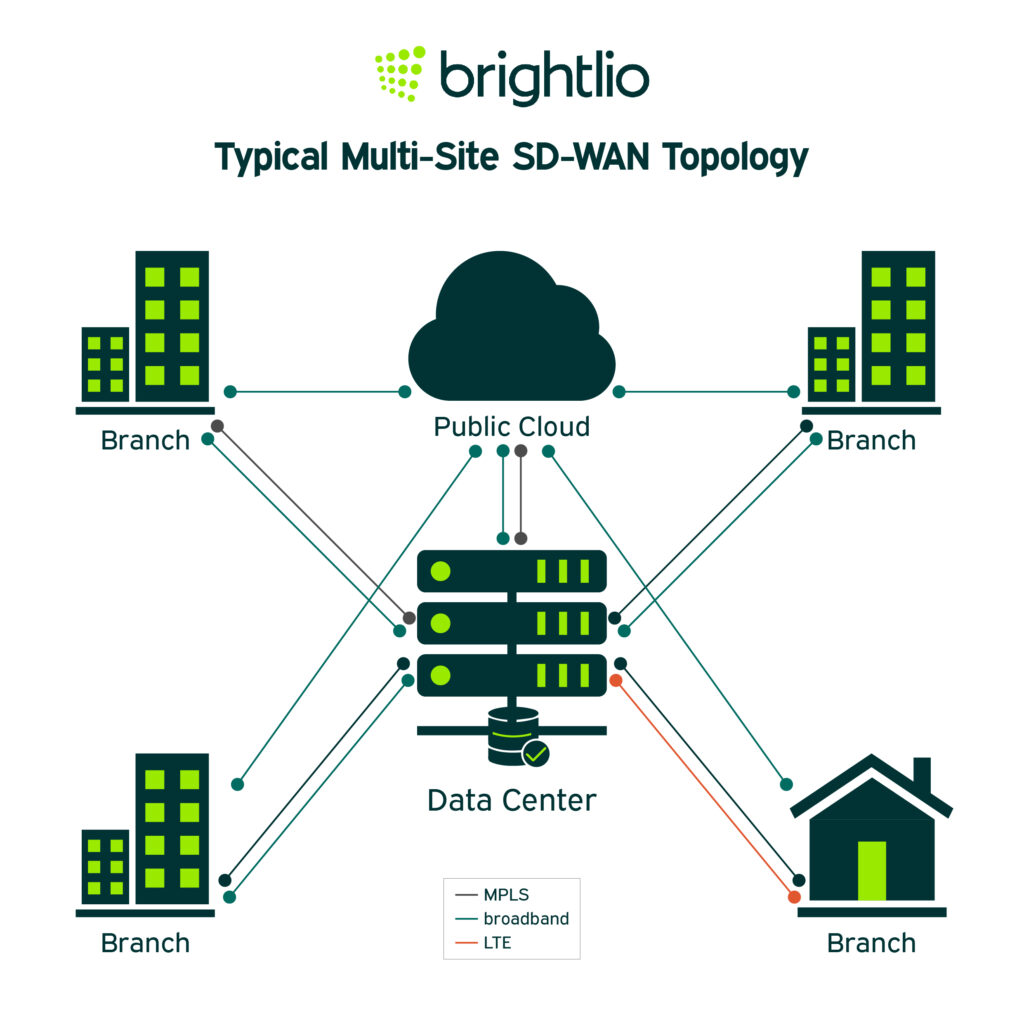
Table of Contents
The Pros and Cons of SD-WAN: What You Need to Know
The SD-WAN market is proliferating due to the performance, reliability, and cost benefits the technology delivers. While there are many benefits of implementing SD-WAN, there are also some drawbacks. Are SD-WAN’s value-added services right for you?
We’ll explore the pros and cons of SD-WAN. If you still have questions or are interested in a price quote or solution design, the team at Brightlio would love to hear from you.
What Is SD-WAN?
SD-WAN, or Software Defined WAN, is a virtual Wide Area Network (WAN) architecture. It uses software to abstract the networking layer, allowing you to use different connection types interchangeably. These include MPLS, broadband, direct internet access (DIA), and LTE. Blending two types of network connectivity together creates a hybrid WAN. As we will explore, there are many benefits of hybrid WAN deployments.
SD-WAN reduces the costs of traditional WAN architecture by allowing customers to access cheaper broadband and LTE internet options rather than more expensive MPLS services. SD-WAN leader, Silver Peak, estimates that customers can reduce networking costs by as much as 80%.
Additionally, SD-WAN is a more flexible architecture for multi-site deployments. In traditional WAN networks, traffic is backhauled to a central location like a colocation facility or headquarters. This topology leads to unnecessary network traffic and potential congestion.
SD-WAN’s software based networking approach allows traffic to route via the most optimal path for the application. This improves performance and network security while allowing businesses to leverage lower-cost, reliable connectivity options.

Alternatives to SD-WAN
Multiprotocol Label Switching (MPLS) is the main alternative for SD-WAN, but it has limits. This networking approach has been around for decades, using bandwidth to connect remote workers and simplify sharing files between numerous users. While MPLS is proven and resilient, it is also expensive and rigid.
Secure Access Service Edge (SASE) is an emerging technology and another SD-WAN alternative. Rather than connecting branches and colocation facilities, SASE connects users to the SASE provider’s cloud through distributed points of presence. SASE incorporates the functions of SD-WAN but also adds in firewall-as-a-service and secure web gateways.
Virtual Private LAN Service (VPLS) uses Ethernet connections to transfer data. It connects multiple devices to the same network and can help expand the reach of a more traditional MPLS system. There’s more flexibility than straightforward MPLS, but you still need Ethernet LAN connectivity, which can limit the data transfer speeds and efficiency while raising costs. For more information about private WAN services, check out our helpful guide.

SD-WAN Pros and Cons
A study from 2020 shows that 52% of United States businesses used SD-WAN networks. However, that impressive statistic doesn’t mean it’s the right option for your needs. Before choosing the connectivity solution for your business, ensure you know the SD-WAN pros and cons. This will provide a complete picture to determine if SD-WAN is right for you.
Pros of SD-WAN
There are many advantages to SD-WAN that make it a great choice for many of our customers. We’ll outline them here.
SD-WAN ROI: It Saves You Money
A primary reason for implementing SD-WAN services is to reduce WAN costs. Rather than purchasing expensive MPLS circuits, SD-WAN allows customers to utilize lower-cost options like broadband and LTE. These services can then be bonded together. This allows lower circuit costs to combine with the financial benefits of improved uptime, further improving SD-WAN ROI.
SD-WAN can be used in conjunction with MPLS. Broadband connections can serve as backup circuits. Home office workers can be outfitted with small SD-WAN appliances that usually also function as firewalls. This allows them to connect to the network with their home broadband or LTE connection with the same level of security and monitoring they get from the office.
SD-WAN Improves Network Performance
SD-WAN improves the performance of your entire network by bonding together multiple WAN links and allowing them to be used simultaneously. This provides a bigger pipe through which to pass traffic. The SD-WAN technology then routes traffic through the highest-performing link.
SD-WAN is application-aware and will route latency-sensitive applications based on the quality of service (QoS) policies. Coupling SD-WAN with unified communications and similar applications adds a lot of value.

SD-WAN Improves Reliability
SD-WAN solutions bond multiple WAN connections in an active-active link configuration to connect multiple sites. The system will automatically detect link failures and reroute traffic accordingly.
A highly redundant SD-WAN architecture might include three connectivity types: A primary MPLS connection, a secondary broadband connection, and a third LTE connection. All connection types are used simultaneously, maximizing investment and network capacity. A branch might lose the MPLS and broadband connections during a power outage. Assuming a UPS powering the SD-WAN appliance, you would still have internet connectivity and connectivity to the data center via the 5G/LTE circuit. We’ve seen this topology deployed successfully in retail stores and other deployments with many small sites.

SD-WAN is More Secure
SD-WAN networks are more secure than MPLS or broadband networks alone. It forms end-to-end encrypted tunnels across the network to securely connect users and applications. This means your sensitive data is safe, even if it traverses the public internet.
Additionally, many SD-WAN appliances are also next-generation firewalls. This means they come with many other security features, including application firewall, intrusion prevention, deep back inspection, anti-virus protection, and more.
SD-WAN is Easier to Manage
SD-WAN centralizes the network management function. Your network can be administered company-wide via a single pane of glass. This provides a more holistic network view, including a broad array of network statistics. It also allows you to better forecast network performance requirements and capacity upgrades. There are also software as a service options that allow you to deliver the value of SD-WAN without managing hardware.
Another benefit of a centralized architecture is that you can streamline security and compliance. Remote branches and home users can be treated with the same rigorous security protocols as main branches and data centers. With an SD-WAN architecture, you can incorporate tools that protect your data and stop threats at the network level instead of expecting each location to follow a set of corporate best practices that might be difficult to monitor.
Cons of SD-WAN
As you can see, SD-WAN offers many advantages. There are some drawbacks to consider, as well, however.
SD-WAN Could Be More Work for Your IT Team
The carrier entirely administers an MPLS network. Many SD-WAN solutions require your IT staff to configure and maintain them. The extra administration required is one of the weaknesses of SD-WAN. If you have a team of network engineers on staff, they can handle this function. It will add additional responsibilities to their plate, however.
If your company has engineering expertise, you may be able to manage, monitor, and maintain an SD-WAN network. There are managed service providers that will take care of this for you. There are also SD-WAN-as-a-Service providers. While these can be great options, they also add cost, thus somewhat negating the cost savings benefits. Deciding between a DIY vs managed SD-WAN deployment is an important purchase consideration.
The SD-WAN Marketplace is Confusing
The SD-WAN market is pretty confusing. Understanding what technology to pick and the various terminologies related to SD-WAN can inhibit adoption.
First, there are many vendors in the space: Cisco, Fortinet, Juniper Networks, Palo Alto Networks, Versa, and VMware are just a few of the players. Additionally, there has been tremendous M&A activity in the space. VMware bought VeloCloud. Cisco bought Viptela. HPE bought Silver Peak. This brought rebrands, name changes, technology changes, and more. The product name “Cisco Meraki SD-WAN Powered by Viptela” illustrates the confusion.
It’s tough to see clearly through the fog of vendor messages and product names. This is where a technology consultant like Brightlio adds much value. We know the players in the market and can assess your needs to deliver the right solution for you.

There Are Emerging Alternatives to SD-WAN
The SASE architecture we described earlier is a viable alternative to SD-WAN for some use cases. It takes a more cloud-centric approach and eliminates some of the management challenges presented by SD-WAN.
Secure Service Edge (SSE) is another approach. SSE consolidates firewalls, secure web gateway, zero-trust network access (ZTNA), and cloud access security broker (CASB) technology into one. This is also more of a cloud-centric approach than traditional SD-WAN.
These technologies are converging, however. Many technology leaders in the SD-WAN space are touting SASE and SSE capabilities. SD-WAN, SASE, and SSE technologies will likely continue to converge. If you procure an SD-WAN solution from one of the leading providers, you will likely be able to take advantage of the benefits of all three technologies.
Conclusion
After evaluating the pros and cons of SD-WAN in detail, it is clear that the advantages outweigh the disadvantages. SD-WAN is a compelling solution assuming you have an engineering team or SD-WAN value added services partner you trust to administer the solution and a partner to help you pick the right provider.
Brightlio – Your SD-WAN Partner
Brightlio is a technology consultancy and telecommunications broker. Our team has 20 years of IT experience. We partner with leaders in the SD-WAN, SASE, and SSE space and can help you find the optimal solution for your needs and budget.
Additionally, we partner with leading dedicated internet access, broadband, and LTE providers, as well as colocation and cloud solutions. This allows us to offer you a complete network connectivity and technology solution for your business.
If you are interested in learning more about SD-WAN, we would love to hear from you. Quotes and solution designs are always free. Get started with Brightlio today!
Recent Posts
10 Largest Underground Data Centers in the World
100+ VoIP Statistics from Credible Sources (Jan – 2026)
10 Largest Data Centres in the UK
Data Centers in Maine – An Overview
Let's start
a new project together



